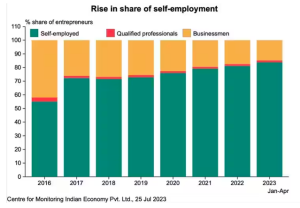Context:
The latest data from the Centre for Monitoring Indian Economy (CMIE) suggests that In just three years from January-April 2019 to 2023, India’s workforce experienced a significant expansion, the number of self-employed businesspersons witnessed an impressive increase during this period.
Trends In Employment In India:
- Total Employment: As of January-April 2023, there were 412.9 million employed individuals in India.
- This number had increased by 8.6 million compared to the pre-pandemic level in January-April 2019.

- Categories of Employment:
- Farmers: The largest employment category in India consists of farmers, who are involved in agricultural activities.
- Wage Labourers and Small Traders: The second largest category includes wage laborers and small traders.
- Salaried Class: The third biggest category is the salaried class, which includes individuals working in various organized sectors.
- Business Class or Entrepreneurs: The fourth biggest category includes individuals engaged in business and entrepreneurship.
- Employment Trajectories:
- Business: The “business” category has fully recovered to the pre-pandemic level, with the number of people employed in this sector growing by 8.4 million in the last four years.
- Salaried Class, Wage Labourers, and Small Traders: These three categories have not yet fully recovered to the pre-pandemic levels, as the number of people employed in these sectors is still below what it was during January-April 2019.
The “business” class in India can be compressed into three main sub-categories:
- Businessmen: Individuals running large businesses, managing fixed premises (offices, shops, factories) using capital and human resources.
- Qualified Self-employed Professionals: People who run their own professional enterprises based on their expertise (e.g., doctors, lawyers, consultants, chartered accountants).
- Self-employed: Entrepreneurs managing their own businesses with limited financial, human, or professional resources (e.g., taxi drivers, barbers, real estate agents, models, astrologers).
Rise of Self-Employment:

- Self-employed entrepreneurs accounted for the largest share, at around 70-80 per cent .
- According to CMIE, the share of businessmen fell substantially and was offset by an equal rise in the share of self-employed entrepreneurs.
Findings on data analysis:
- Decline in Traditional Business Class: The well-to-do entrepreneur class in India is experiencing a secular decline, both in absolute numbers and as a proportion of the population.
- Rise in Self-Employment: Self-employment is on the rise in India, with individuals starting businesses using limited resources and capital.
- Concerns about Real Entrepreneurship: The increase in self-employment raises concerns about genuine entrepreneurship, as it might be driven by limited employment opportunities rather than true entrepreneurial ventures.
- Economic Conditions: The growth in self-employment could indicate economic challenges and limited job opportunities in organized sectors, leading people to opt for self-employment as a means of livelihood.
What should India do?
- Shift from Agriculture: Utilize the existing labour force by shifting a major chunk (45.5%) engaged in agriculture with low productivity to other sectors.
- Labour-Intensive Manufacturing: Focus on labour-intensive sectors like textiles, toys, footwear, auto components, sports goods, and agricultural processing to provide employment opportunities.
- Potential Sectors: Explore sectors like restaurants, hotels, mining, construction, healthcare, and caregiving services for further job creation.
- Infrastructure Development: Accelerate infrastructure development to reduce trade costs, facilitate trade, and support the growth of the manufacturing sector.
- Skilling and Upskilling for Productivity:
- Skill Development Programs: Utilize initiatives like Jan Shikshan Sansthan, Pradhan Mantri Kaushal Vikas Yojana, and National Apprenticeship Promotion Scheme for enhancing human resource skills.
- Focus on Unorganized Sector: Address the underpaid employment in the unorganized sector (where 93% of employment lies) by upscaling skills and creating a high-skilled ecosystem.
- Education and Health Facilities: Invest in quality education and healthcare to ensure a productive and healthy labour force.
- Healthcare Reforms:
- Ayushman Bharat and Swachh Bharat Mission: Ensure health equity by implementing wide-ranging reforms in healthcare.
- Accessibility and Affordability: Scale up access to quality healthcare services, make drug prices affordable, and implement the Pradhan Mantri Bhartiya Janaushadhi Pariyojana.
- Universal Insurance: Work towards providing financial medical protection through universal insurance coverage.
- Quality Education:
- National Education Policy 2020: Emphasize updating knowledge and creating productive employment opportunities.
- Inclusive Education: Implement the Samagra Shiksha program for inclusive, equitable, and quality education at all levels.
- Improve School Education: Focus on delivering quality education up to higher secondary level to build a skilled labor force.
Conclusion:
India’s next 30 years belong to its potential if reforms are accelerated and flagship programs like Skill India, Make in India, and Start-up India yield desired outcomes. Focusing on labor-intensive manufacturing and human capital can make India a global labor force source.
| Additional Information:
India’s Demographic Advantage:
- Average Age: India’s average age is 29 years, indicating a youthful population compared to other major countries like the US, China, France, Germany, and Japan.
- Rising Working-Age Population: India is currently experiencing a phase of increasing working-age population, which presents a unique opportunity for economic growth and development.
- Decreasing Old-Age Dependency Ratio: The old-age dependency ratio in India is declining, meaning there are fewer elderly dependents relative to the working-age population, leading to a potential demographic dividend.
- Ageing World Population: In contrast, the world is witnessing an ageing trend, with many countries experiencing an increase in the proportion of aged individuals.
- Drastic Reduction in Fertility Rates: Many countries, including China, are facing record low fertility rates, leading to a shrinking labour force and potential economic challenges.
- Youthful Population Among Populous Nations: India stands out as one of the youngest countries among the most populous nations globally
To harness the demographic dividend, the focus should be on improving labor force participation, employability, and creating employment opportunities for the youth. |
News Source: The Indian Express
![]() 1 Aug 2023
1 Aug 2023


